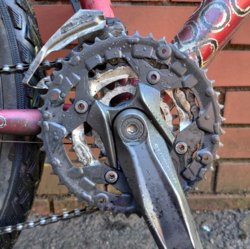OK, that photo reveals a lot more.
The area I circled in red is the powerstroke area from your right leg.
The area in green is the dead zone.
Have a look how much more the teeth are worn in the red area than green.
View attachment 507989
The shape of worn teeth represent shark fins (not shark teeth as often quoted, because shark teeth are symmetrical and chainring tooth wear is asymmetrical) with the sharp end pointing forward.
The is because the chain pulls on the teeth and wears pockets into the leading edge, eventually creating an area that's hollowed out, hence the shark fin shape that points forward.
What happens under these conditions is that the chain defaults to a position on the chainring that's not centre on the teeth but pulled back, with the centre of the chain bushing slightly behind the centre point of the tooth.
Eventually, this causes the new incoming tooth (as the ring rotates) to hit the next available bushing, instead of missing it. This creates a specific noise and a vibration. Both will be noticeable only to the mechanically sympathetic, mechanical-minded person.
It is time to replace your chainring.


